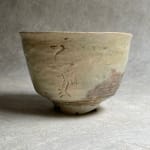






artisan's name unknown
Gohon Yaki Crane Tea Bowl, late 1800s
ceramic
4 1/2'' d x 3 1/4'' h
Further images
This tea bowl’s beauty comes from its simplicity. Looking at it and handling it are both absorbing experiences. Visually, there are so many subtle color changes - rich earthy greens...
This tea bowl’s beauty comes from its simplicity. Looking at it and handling it are both absorbing experiences. Visually, there are so many subtle color changes - rich earthy greens with a hint of blue and slight reddish pink that happened in the kiln with the clay and glaze. The cranes carved on the surface are an admired motif for Gohon Yaki, as the bird was the emperor's favorite. It was the fashionable decoration of the times. The bottom of the inside of the bowl has a smooth, satin finish. It contrasts and compliments the shine of the outside surface. The non-uniformity and texture of the hand-worked clay make this bowl a treat for our sight and touch.
Japanese craftspeople established a kiln in Korea in the 17th century. They taught Korean potters to produce tea bowls with a particular liking for Tsushima Daimyo (a warlord). From the Daimyo, the tea bowls were sent as gifts to many other Daimyos and cherished by them, and the Gohon Yaki style became known among connoisseurs.
The name, Gohon-yaki, was derived from the fact that many excellent Japanese tea bowls were brought to Korea for Korean potters to learn from the originals. Gohon is similar to the Japanese word Otehon, which means an example. Later, the Gohon Yaki style of Tea Bowl started to be produced in Japan.
Today, we could serve tea as intended or serve a cold and refreshing cucumber soup.
Japanese craftspeople established a kiln in Korea in the 17th century. They taught Korean potters to produce tea bowls with a particular liking for Tsushima Daimyo (a warlord). From the Daimyo, the tea bowls were sent as gifts to many other Daimyos and cherished by them, and the Gohon Yaki style became known among connoisseurs.
The name, Gohon-yaki, was derived from the fact that many excellent Japanese tea bowls were brought to Korea for Korean potters to learn from the originals. Gohon is similar to the Japanese word Otehon, which means an example. Later, the Gohon Yaki style of Tea Bowl started to be produced in Japan.
Today, we could serve tea as intended or serve a cold and refreshing cucumber soup.
Signup for our Newsletter
You will receive two emails a month from us. One introduces artworks and design works from Kyoto's hidden sources and the other is stories from Misako, sharing insights into Japanese culture.
* denotes required fields
为了回应您的查询,我们将根据我们的隐私政策处理您提供的个人数据。






